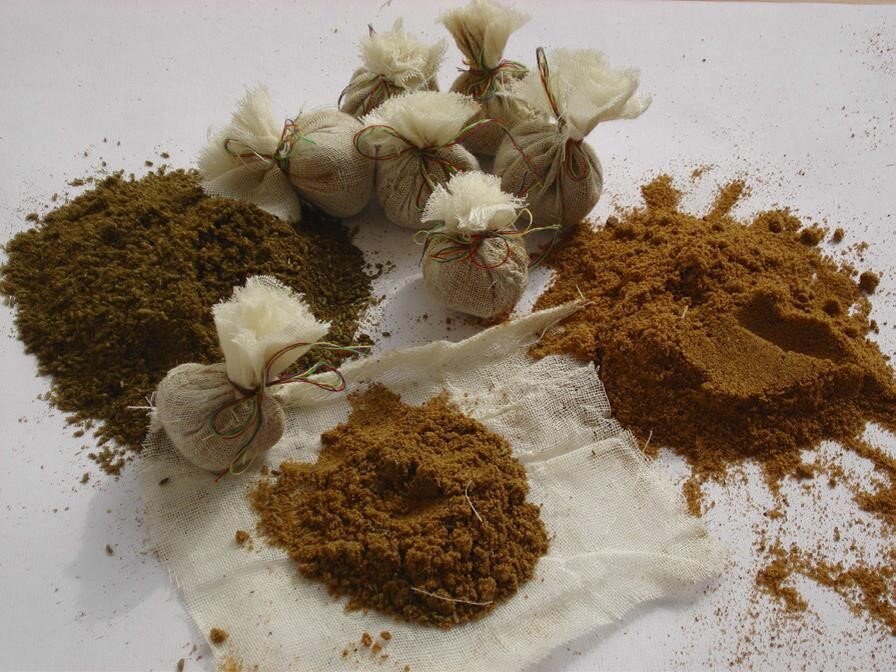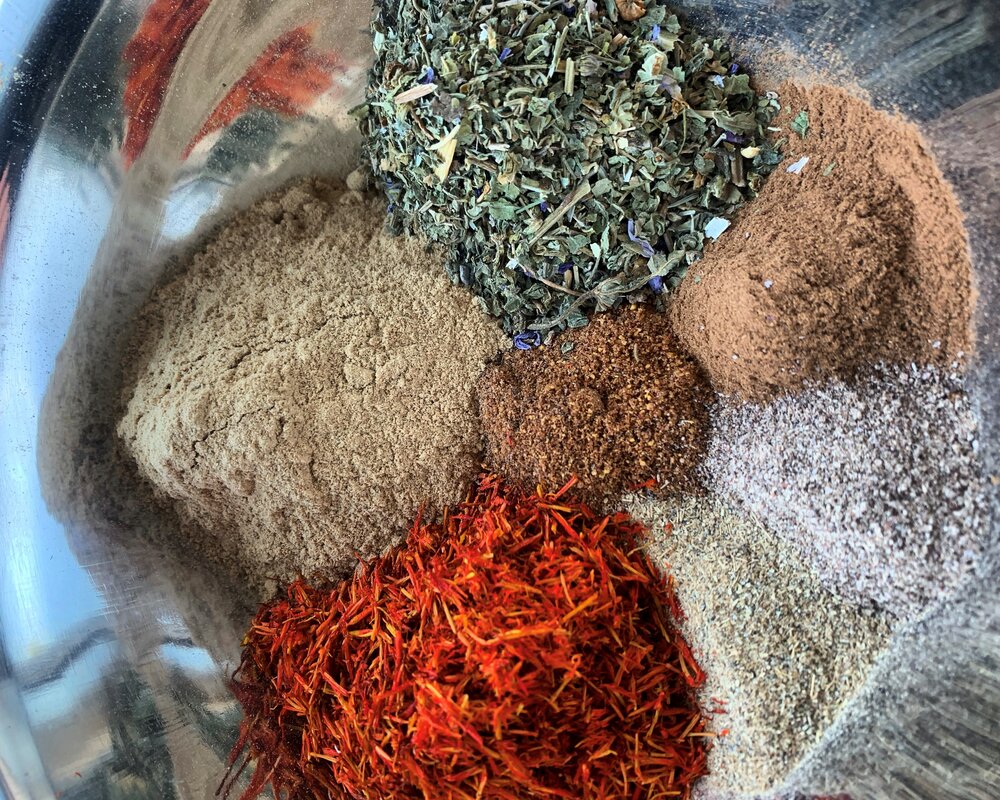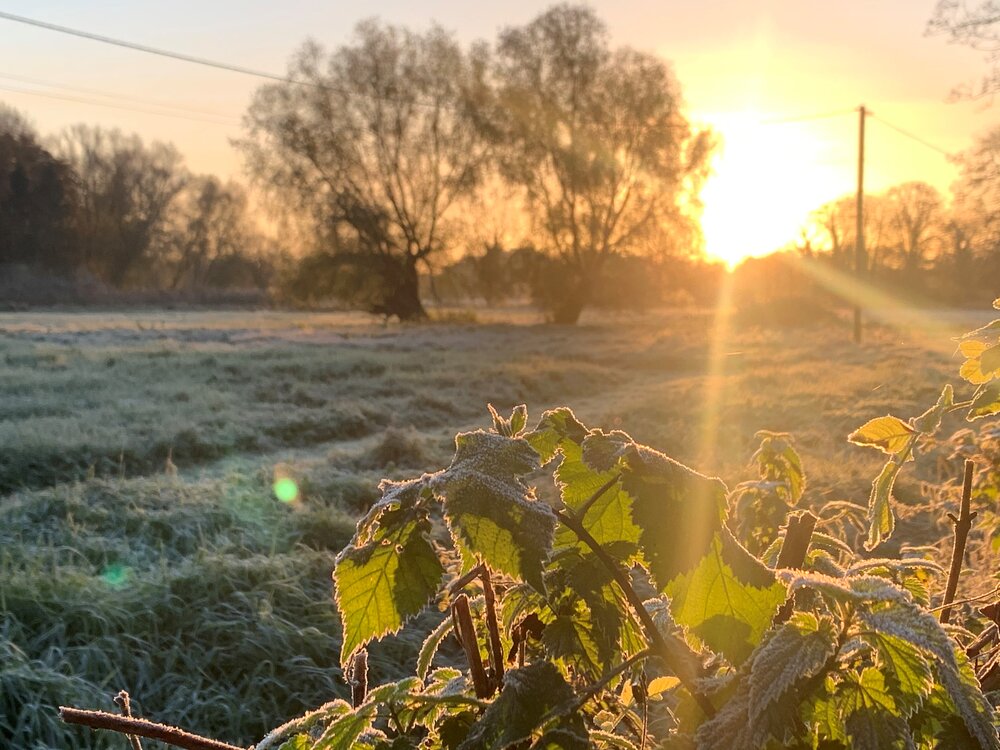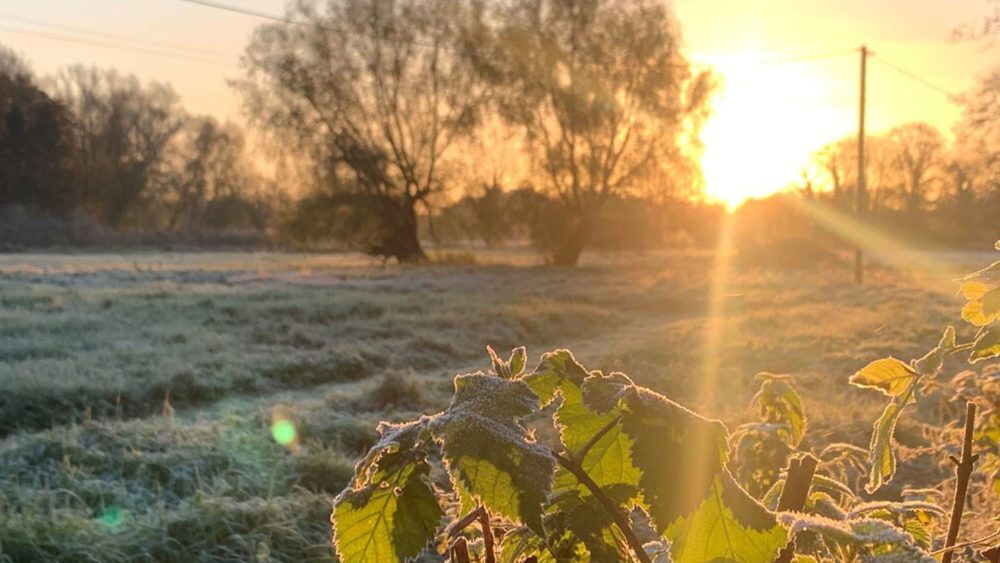By Erik Jampa Andersson
As the days get darker and colder here in London, we begin a new phase in our perennial seasonal cycle. Cold nights, wintery sniffles, and bouts of melancholy can make this a challenging time for many, but our yearly descent into winter is immensely important for maintaining ecological, physiological, and even psychological balance. As a Tibetan Medicine practitioner, I’d like to explore how traditional medicine and elemental cosmology addresses the change in seasons, and some key takeaways that we can use to enhance our experience of wellness in these bizarre times.
Even under normal circumstances, winter can be a difficult season. Especially here in Britain, winter generally means a very long stretch of cold, wet days spent mostly in darkness, only made bearable with cozy snugs in the local pub and evenings spent sharing mulled wine with friends.
The winter ahead is sure to be unusual for a number of reasons. With limitations on indoor activities, the chill of the outer world is bound to be even more formidable, and many of us will find ourselves struggling to find ways to stay balanced and optimistic as we venture into the depths of winter. On top of all of this, there is naturally an increased interest in keeping our bodies healthy and resilient through the impending cold & flu season, which is compounded by the risk of other viral attacks that we would all like to avoid.
Luckily for us, Sowa Rigpa (Tibetan Medicine) offers a wealth of guidance for aligning our “inner world” with the outer dynamics of the seasons, and provides some important context for understanding the ways we’re affected by the transiting cycles of time. In this post, I’ll share some simple recommendations for staying healthy and strong during the winter months. But before we get into practical details, let’s take a look at the underlying elemental theory of these autumn and winter months.
The Seasons and the Elements
Tibetan Medicine is a truly incredible system of traditional medicine. Formed through a potent synthesis of Indian, Chinese, Greco-Arabic, and indigenous Himalayan healing traditions, Sowa Rigpa represents the most sophisticated components of myriad classical medicine systems across Europe and Asia. In the Tibetan medical texts we can find echoes of Taoist medical classics, core Ayurvedic teachings, and even the words of Hippocrates.
Because of its syncretic nature, Tibetan Medicine also offers a uniquely interdisciplinary approach to elemental and seasonal cycles. As an extreme region with many different microclimates, medical theory in the Himalayas expertly navigates local variations in seasonal qualities, and provides us with a powerful blueprint for better understanding our own seasonal experience, even from the other side of the continent.
One of the two main systems which influenced seasonal theory in Tibet is Indian Ayurveda. According to the elemental theory of this system, predominant elemental forces directly impact our bodily energies to create seasonal fluctuations in humoural balance. The Indian system identifies six seasons (spring, summer, monsoon season, autumn, early winter, and late winter), each of which causing certain humoural energies to accumulate, arise, or decline. Because of this dynamic, certain seasons are associated with particular kinds of physiological symptoms (i.e. hay fever in spring), and therapeutic regimens are always adjusted to accommodate these natural fluctuations.

A general depiction of the seasonal processes of the three humours. This is merely an approximation based on our seasonal perspective in the northern hemisphere. But even within the northern hemisphere, seasonal durations and impacts vary, which is why relying on local food is important.
According to this Indian system, we currently find ourselves in the late autumn, standing at the threshold of winter. However, autumns in India and England (or even India and Tibet) tend to be quite different. For Indian medical scholars, autumn meant a hot and dry period following the rainy season. It’s traditionally explained that this heat causes the accumulated heat of summer to arise after being temporarily hidden by the moisture of monsoon season. It’s explained that the earth absorbs the summer heat during this period, inviting plants and animals to direct their energy downward for life-giving warmth and nourishment. For this reason, conditions related to inflammation, fever, and excess tripa (akin to Ayurvedic pitta dosha) are more prominent during this time and are pacified through cooling therapies.
However, we can easily see that this system doesn’t quite perfectly match our seasonal experience. Here in the UK, the “rainy season” is year-round, and autumn is rarely associated with late waves of dry heat. However, as we make the transition into early winter (beginning this month), we will move into a more universal period of chilly dampness, in which pekén (akin to Ayurvedic kapha dosha) will accumulate with an abundance of sluggish, phlegmatic, cold-natured energy.
In the Taoist elemental tradition, which is also present in Tibetan Medical theory, autumn has a slightly different connotation, which more closely reflects our own climate here in Britain. For the Chinese, autumn was the season of the metal element, an archetypal force of descending, penetrating, and cutting energy. It’s located in the west – the direction of the setting sun – representing its affinity with endings, and a poignant death that precedes new birth from the east.
The metal element manifests in our bodies through the “metal” organ system, comprised of the lungs, large intestine, and their sensory expression of smell. Metal facilitates the separation of pure and impure substances in the body, extracting pure oxygen through our lungs and viable fluids through our lower GI tract, while expelling impurities like CO2 and solid food waste. But this dynamic isn’t merely physiological. We also experience the metal element through its effects on our mind. We can look around us as the outer world turns inward, with trees releasing dead leaves to prepare for hibernation and new growth, and find that we actually go through a very similar process. Classical western doctors knew this as the melancholic season, and melancholy is certainly a predominating mental experience during this time. In my research, I’ve found compelling correlations between melancholia and rLung (akin to Ayurvedic vata dosha), and indeed clinical experience clearly demonstrates that the European and American autumn is a ripe time for rLung-related maladies. It’s immensely important that we support our minds and bodies through this time – particularly our respiratory and digestive health, and our psychological capacity to let go of that which no longer serves us.
As we move out of autumn and into winter, the various elemental systems generally converge in a universal association with the water element. The fiery sun wanes in strength while the watery moon is believed to increase in lunar potency. While this can be a difficult time for a number of reasons, it’s actually believed that this cool lunar energy is supremely rejuvenating and nourishing. Winter is more than just a grim stretch of chilly darkness – it’s a powerful time for charging our energetic batteries for a fresh year of growth and expansion. In the Four Tantras of Tibetan Medicine, it’s specifically stated that we reach the peak of our physical power in midwinter, free from the oppressive heat of the burning sun. Particularly as mammals who do not properly hibernate during the winter, this boost in physical strength is an evolutionary necessity for survival in a rather brutal climate.
During the winter months, Sowa Rigpa explains that the pores of our skin become blocked by increased phlegmatic accumulation, which causes wind and heat within the body to increase. This stokes our digestive fire, leading us to naturally consume more food, and the energetic blockage causes cold moisture to accumulate in the inner body. But while the phlegmatic humour accumulates during this time, it doesn’t manifest as Pekén (akin to Ayurvedic kapha dosha) disorders until spring, when waxing solar energy and increased heat causes phlegm to ‘melt’ and descend into the lower organs.
In order to stay healthy through the winter months, it is important that we truly align ourselves with these natural cycles. In modern western society, especially in cosmopolitan areas, it’s common for life to change only minimally from season to season. We often follow the same diet, maintain the same temperature on our thermostat, and perform the same daily tasks. But this departure from seasonal living has had drastic effects on our capacity to evolve and change with the seasons. If we resist change, we will fail to experience the profound beauty of the shifting world around us, and our bodies and minds will suffer as a result.
Therefore, without further blah-blah, here are seven tips for maintaining dynamic health and balance through the winter months:
1. Eat Seasonally
Unsurprisingly, our first consideration should be adjusting our diet for the season. Tibetan Medicine advises relying primarily on foods with naturally sweet, sour, and salty tastes. The ‘sweet’ taste can include substances like whole fruits, but also generally refers to densely nourishing foods including most animal substances, or other substances that are rich in protein and healthy fats. Sweet foods help to balance our wind energy (rLung, akin to Ayurvedic vata dosha), keeping us calm and well-rested with balanced motility in our various body systems. The sour and salty tastes are both described as being partially composed of the fire element, offering an important balance for cool water energy of the winter months.
In practice, this is the golden time for classical English cooking. Savoury pies, stews, and roasts are perfect dietary choices for staying nourished and balanced in winter. In particular, root vegetables like turnips, sweet potatoes, beetroot, and so on are excellent options for a nourishing vegan meal, as well as gourds, nuts, whole grains, and seasonal fruit. It’s a great time for preparing warming stews with spices such as ginger, turmeric, and garlic. In addition to their culinary uses, these are all excellent medicinal substances to use throughout the winter. For those who eat animal products, bone broth is one of the most valuable nutritional resources to cook with in the cold season.

If you struggle with excess sluggishness and lethargy, cruciferous vegetables (many of which grow through the winter) are good options for increasing motility and energy in the body, but care should be taken when afflicted with digestive issues. If you find yourself restless and stressed, especially with sleeplessness that strikes in the middle of the night, then calming the wind energy with a healthy dessert is highly recommended. Personally, my favorite healthy winter dessert is baked apples with a bit of nutmeg, cinnamon, cardamom, clove, honey, and ghee (alternatives to animal products are perfectly fine). Eaten before bed, this always helps ensure a restful night of sleep if I’m feeling restless.
Perhaps most important is what to avoid during this time. Especially in order to encourage healthy immune function, we should limit our intake of sugar as much as possible. This does include fruit juices and other sources of “natural” sugar, unless it is in whole fruit form. Pomegranate, for instance, is a phenomenal fruit to enjoy through the fall and winter. But many people opt for juice because the process of opening a pomegranate can be rather laborious and messy. Unfortunately, this lacks all of the essential fibre that our body needs to process the excess sugar, and our body suffers as a result.
We should also avoid excess raw/uncooked, cold, processed and old foods. These are tremendously difficult to digest, and tend to increase phlegmatic qualities in the body. Salad is not always the answer when searching for a healthy meal option. For most people, even simply steaming your veggies before consumption can have marked benefits for your metabolic function and assimilation of nutrients. Foods that have been frozen for long periods of time also absorb some of the stagnant, cooling energy from the process, depriving them of the essential vitality that our body really needs. Therefore eating fresh seasonal (and ideally local) produce is always the best option not only for the planet, but also for our bodies.
In addition to all of these general seasonal benefits, maintaining a healthy metabolism and adequate nourishment is one of the absolute most important ways we can foster greater resilience against disease. In Tibetan Medicine, it’s explained that the most subtle refined essence of the food we eat, known as dang, is largely responsible for supporting our physical radiance and vitality. The health of our dang is dependent upon the strength of our digestion. If our metabolic process is hampered at some point by imbalanced energies or bad food, then our immune system is just one of the many things that will struggle. So if you want to stay healthy, be sure to pay attention to your gut. Western science has affirmed this connection through understanding of the gut-associated lymphoid tissue (GALT), which represents almost 70% of the entire immune system – and this gut tissue contains around 80% of our immune-boosting plasma cells (especially those bearing immunoglobulin A).
With all of the extra time at home, try to take advantage of the greater control you have over your meals. Replace processed foods with simple, warm, whole food-based meals whenever possible, and remember the timeless Hippocratic maxim: “Let food be thy medicine, and medicine be thy food.”
2. The Virtues of a Hot Cuppa
Most of us already have a morning beverage ritual. Whether it’s preparing a fresh pot of tea or pressing a button on the coffee machine, most people naturally enjoy drinking a warm beverage first thing in the morning. This is certainly not by accident. Yes, a hot drink can help us cut through the chill of the morning, but the warming benefits go beyond mere sensory perception. Our digestion is fundamentally a hot function. When we feed it warmth, especially in the morning, we help to kick-start our metabolic process and prepare our “inner cauldron” for a new day of nourishment.
Coffee and other highly-caffeinated drinks can be sustainable for some people, but for those who are prone to nervousness or adrenal imbalance they are generally contraindicated. For those who tend towards adrenal fatigue (often manifesting with fatigue, sensory sensitivity, lower back pain, etc.), coffee addicts may find some benefit simply in mixing their coffee with a pinch of cardamom – some may know this as “Turkish coffee.” Cardamom is a phenomenal plant medicine for the kidneys and adrenals, and is believed to help counteract some of the depleting effects of coffee.

Perhaps the best option, however, is what we know in the west as chai. While “chai” simply means “tea” (tea is almost always either called “cha” or “té” worldwide), Indian forms of sweet/spicy chai are usually prepared with a mix of lovely warming spices like nutmeg, cardamom, cinnamon, clove, star anise, allspice, and ginger, which are boiled in order to extract their ‘active’ components. You can prepare a chai blend with or without tea, adding milk or a milk substitute along with a natural sweetener like honey, raw sugar, or agave to make a lovely morning beverage.
Even alcohol has its place, depending on the individual and volume. A small glass of mulled wine is a perfect traditional drink to wind down on a cold evening, or alternatively a little bit of warm sake. Hot buttered rum is another drink that is in fact not so dissimilar from a traditional Tibetan home remedy – though it’s certainly not helpful in excess or for every person. As always, take care not to overdo it, as excess alcohol causes far more harm than good for the body and mind.
3. Keep Sensibly Warm
It may seem overly-obvious, but it is quite important to stay warm during the winter. However, it’s equally important not to barricade yourself in a heated flat all winter. Part of our modern society’s struggle with seasonal transitions lies in our insistence upon pervasive climate control. Spending summer in front of the A/C and winter next to the heater can throw off our body’s natural ability to adjust with our seasonal fluctuations, so it’s best to be sensible in how much we try to escape the weather. Do try to get outside (i.e. for socially-distanced exercise) when possible, and try to keep your thermostat around 20°C to best support your body and the planet.
That said, it’s considered to be particularly important to protect our water organs during the winter months – namely our kidneys and urinary bladder, as well as their sensory manifestation in our ears and auditory faculty. We’re advised to keep our waists warm with adequate clothing, as well as our knees and feet, both of which are considered to be connected with our kidney health. In the Himalayas, it’s common to see people with wraps and shawls tied around their waists in the cold weather, in order to protect their most sensitive cold-natured organs from the chill. Our ears should also be protected from excessive cold, especially if suffering from lower back pain or phlegmatic illnesses. The ears are the “flower” of the kidneys, offering both diagnostic information about our renal health as well as a gateway for accessing these essential organs.

4. Self-Massage and Oil Therapy
In the Tibetan tradition, one of the best therapies for calming wind and supporting balanced heat in the body is oil massage (kunyé). We usually use sesame oil for its heating properties, though this can be adjusted based on your own constitution and preferences. While receiving a professional healing massage is ideal, it can also be quite beneficial to swap massages with your spouse or lockdown buddy, or even to practise some self-massage pampering on your own.
Warm up a little sesame oil in your hands and massage it into the palms of your hand, soles of your feet, and crown of your head. These are important “gates of wind” in the body, and treating them with oil massage is an excellent way to encourage balance and relaxation – especially before bed. Also give your shoulders, legs, and arms a rub – they deserve it. Unless you suffer from excessively oily skin, there’s no need to wash off the oil after application. Let it seep in for optimum effect. You’ll be so relaxed that you won’t even hear your spouse complain about how you smell like a wok.

Another brilliant therapy is known as hormé, a hot compress therapy using herb satchels dipped in heated oil, which are applied to particular points on the body along with gentle massage. This is a bit more involved and requires some explanation from a practitioner, but it’s very worth learning as a simple yet effective home therapy.
5. Herbs for Immunity
When it comes to building immunity and retaining resilient balance, it is primarily important that we pay attention to the nutritional and lifestyle needs for our individual constitution. However, plants can also be tremendously valuable allies in this time, as long as they’re used wisely.
There are a number of herbs that are touted as “antivirals,” and while many of them have indeed exhibited antiviral effects in scientific studies, it would be irresponsible to suggest that there is any bonafide herbal cure or preventative treatment for viruses like Covid-19. At the end of the day, preventing exposure is the very best thing we can do to stay healthy during this time. Wear your mask when adequate social distancing is impossible, and self-isolate if you are advised to do so.

That said, we can and should certainly make use of available herbs to support our immune function in order to stay strong, not only against Covid-19, but also seasonal colds and flus. One of the best options available to us in Britain is Black Elderberry (Sambucus nigra). However, it is very important that this is only used when healthy, and not once we have fallen ill. This is because Elderberry works, in part, by increasing immune cell release of tiny chemicals called cytokines. In particular, it is connected to an increase of IL-1B, a cytokine component of the inflammatory reaction triggered by Covid-19. This is not a reason to avoid Elderberry altogether, but rather supporting evidence for its traditional use as a preventative treatment against colds and flus, as opposed to a treatment for active infection. Elderberry syrup is a common and quite tasty preparation which can be taken throughout the winter to support healthy immune response, and there is a long tradition of making hand-foraged elderberry preparations (though the harvesting season has now passed until next year). Be sure not to eat raw Elderberries or any other parts of the Elder tree, since they are toxic.
In China, one of the main herbs used to support immunity against a number of viral infections is Astragalus root (Astragalus membranaceus), which is similarly useful before getting sick, but not during an active infection. This herb gained a lot of attention this year, and was used widely throughout China to encourage a healthy immune response, especially in combination with other supportive herbs. It’s sometimes explained that taking Astragalus is like locking the doors and windows to your home. It can help to keep robbers out, but if they’re already in the house, then you’ll just be locking them in. So use with caution.
For active infections, it’s really crucial to seek professional medical advice and, when appropriate, the guidance of a qualified herbalist or naturopath for holistic support. For those who already work with herbs, in lieu of specific recommendations I will say that it’s tremendously important to address the non-respiratory aspects of Covid-19 infection, should you or a loved one become ill. The blood-thickening effects of the disease, especially for those who are hypertensive, should not be ignored. Covid, unfortunately, is not just another respiratory disease – it has many more sinister and long-lasting effects on our health, and for some, long-term healing therapies may be necessary to return the body back to a state of balance. As always, consult with your general physician before beginning any herbal or complementary medicines.
6. Mind your Shadow
Among the many challenges we will face in the months ahead are struggles relating to mental health. As we discussed, autumn and winter are a time for turning inwards – for confronting our own inner darkness and shadow elements in order to arise fresh and renewed in the spring. Don’t become overly concerned or self-critical if you find yourself cycling between periods of melancholy, frustration, restlessness, sadness, and so on. This is natural in normal times, and is wholly understandable in abnormal times like the present.
When possible, try to retain real human interactions. Don’t worry about keeping up with every one of your distant acquaintances on social media. Winter isn’t the time for fluttering around like a cyber social butterfly. Instead, focus on a few close friends or relatives that you know you can call up or have a video chat with whenever you’re feeling down. Relaxing with small groups of good friends is a specific treatment for excess rLung in Tibetan Medicine, and social distance doesn’t necessarily need to prevent us from experiencing therapeutic intimacy with those we love.

However, for many of us, Zoom calls will certainly not be enough. It’s been a difficult year, and the prospect of potentially spending winter and the holiday season in lockdown is quite grim. Maybe we feel weighted down by regrets about the past year or fears surrounding the uncertain future ahead. This is a potent time for re-centering, re-visioning, and addressing any of the pesky inner ‘demons’ hiding in the dark corners of our psyche.
I’m a big fan of therapy, and highly recommend it for anybody who feels they need some extra psychological support during this time. But personally, the single most effective technique I’ve encountered for working with psychological distress is called Feeding Your Demons. Developed by my root guru, Lama Tsultrim Allione, as a modern secular adaptation of a traditional Tibetan practice called chöd, this five-step process is used by individuals and therapists across the world to uncover, dialogue with, and resolve the myriad ‘demons’ that haunt us.
Regardless of how you choose to work with your own psychological burden, this is certainly a perfect time to take stock of where we’re at, what we’re clinging to, and what kind of future we want to create. Let go of that which no longer serves you, and make room for new growth ahead.
One thing you can do is hold a personal Winter Solstice ceremony. On the eve of solstice, write down a list of things you want to release from the previous year, including any fears, traumas, dramas, regrets, habits, or obsolete modes of being that no longer serve you. As you generate the heartfelt intention to actively release all of this for the benefit of yourself and others, burn the paper (safely!). Then take some time to contemplate your aspirations for the year ahead. Write these in a little note – even on your phone – that you can revisit in the year ahead. Who do you want to be in the new year? What principles do you want to guide you? Every day is a new beginning, but there is perhaps no more poignant time for rebirth than the new solar year.
7. The Power of Light
One of the most absolutely essential components of maintaining physical and mental resilience at this time is maintaining therapeutic levels of Vitamin D3. In Tibetan medical texts, it’s highly recommended that individuals bask in the winter sun whenever the weather allows. This has a number of benefits, but modern science understands the skin’s synthesis of Vitamin D3 from sunlight as a primary component of its therapeutic value.
Since most of us do not (and often cannot) get enough sunlight in the winter, it’s important to consider supplementation through diet, vitamin supplements, and behavior. Some people, especially those who struggle with Seasonal Affective Disorder, choose to engage in “light therapy” with a specially-designed UV lamp. While many people extol the virtues of this kind of treatment, exposure to high amounts of UV light can increase the risk of skin cancer, and scientific evidence of its efficacy is somewhat scant. Some lights feature very small amounts of UV radiation, which may be a safe way of brightening up an otherwise dark winter. In any case, certainly do try to get in the sun whenever possible.

In general, it’s considered perfectly safe to take 2,000 IU/day of a Vitamin D3, though for optimum therapeutic value it is sometimes advised to take more. As always, consult with a physician or healthcare practitioner for guidance when using higher doses of vitamin supplements.
This post was written by Erik Jampa Andersson, and is posted here with Erik’s permission. For more information about the “Cultivating Wellness as the Light Returns” Winter Solstice Virtual Retreat Erik will be leading on December 19 – 21, click here.
About Erik Jampa Andersson
Erik Jampa Andersson is a practitioner and instructor of Sowa Rigpa (Traditional Tibetan Medicine) and the Yuthok Nyingthik. He is one of the few westerners to have completed a comprehensive education in the Gyu-zhi (Four Medical Tantras), as well as practical training in Tibetan herbalism, clinical treatment, and astrology. He established his clinical practice in Los Angeles in 2017, but has since moved across the pond to England, where he is now the director of Shrīmālā Healing Arts and resident teacher at Sorig Khang London. A longtime fixture in the Tara Mandala community, Erik first … Read more »





